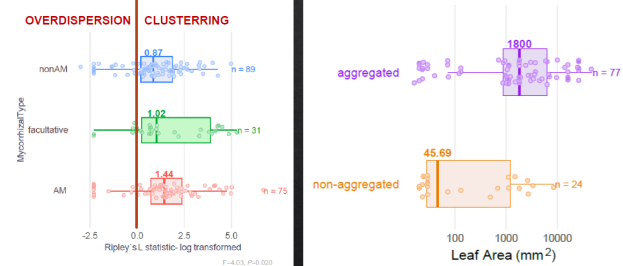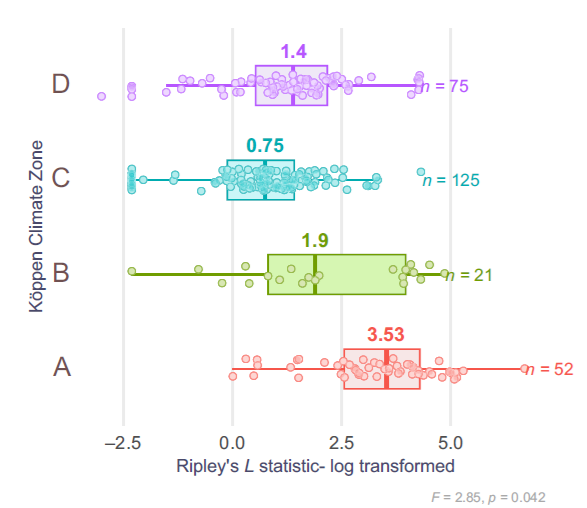It is a gas lab: Meta-analysis reveals that leaf area drives the spatial distribution of trees.
Members of the It is a gas lab, at the School of Ecology at Sun Yat-sen University have published an article in Global Ecology and Biogeography with the title Leaf area predicts conspecific spatial aggregation of woody species. The article was led by the PhD student Jingjing Xi who is the first author, MSc students Guolin Li and Min Wang are second and third authors, whereas Stavros Veresoglou is the senior and corresponding author. School of Ecology of Sun Yat-sen University is the first unit of the paper.
Link: https://onlinelibrary.wiley.com/doi/full/10.1111/geb.13887
The article addresses a set of four hypotheses addressing the relative importance of biogeographical drivers and plant traits in determining spatial aggregation patterns across conspecifics in woody habitats. The results are based on the meta-analysis of 69 studies with a global coverage.

Fig. 1. (left) Instances of spatial aggregation (outcome at the distance where Ripley's L statistic deviated most from randomness) in our dataset classified based on the leaf area of the plant species; (right) Variance statistics in Ripley's L statistics across mycorrhizal association state of the plant species.
The two main results of the study are that there were differences in conspecific spatial aggregation patterns across species associating with different mycorrhizal types and that large-leafed species were considerably more likely to present a conspecific spatial aggregation (Fig. 1). Climatic variables explained about twice the variance that plant traits explained in relation to conspecific aggregation patterns (Fig. 2).

Fig. 2 Conspecific spatial aggregation statistics (Ripley’s L statistic) across the four Koeppen Climate zones. The figure captures the massive effect of climatic variables on conspecific spatial aggregation patterns of trees.
Through their analysis the authors address “how local-species interactions influence large-scale diversity gradients”. There is an appreciation that we need large-scale observational studies to address the relative contribution of the species pool and the habitat to conspecific density dependencies so that we can subsequently design elegant experiments to address the underlying mechanisms and we agree with them. This analysis contributes towards this direction.
作者简介

Jingjing Xi and Stavros Veresoglou Begum are members of the it is a gas lab at the School of Ecology at Sun Yat-sen university. The expression “it is a gas” in English means that something is thoroughly entertaining. In the it is a gas lab, we work on greenhouse gases and we really enjoy ourselves (we are actually equipped with our own gas chromatograph). The focus of the lab is on global change biology and a lot of the ongoing research addresses mycorrhizas, symbiotic associations between the roots of terrestrial plants and fungi. For inquiries to join the lab please contact (inquiries can be in Chinese or in English) Junjiang Chen (陈俊江) at chenjj353@mail2.sysu.edu.cn.



